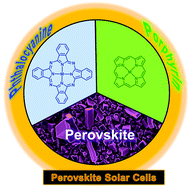Phthalocyanines and porphyrinoid analogues as hole- and electron-transporting materials for perovskite solar cells
Abstract
Organic–inorganic lead halide perovskite absorbers in combination with electron and hole transporting selective contacts result in power conversion efficiencies of over 23% under AM 1.5 sun conditions. The advantage of perovskite solar cells is their simple fabrication through solution-processing methods either in n-i-p or p-i-n configurations. Using TiO2 or SnO2 as an electron transporting layer, a compositionally engineered perovskite as an absorber layer, and Spiro-OMeTAD as a HTM, several groups have reported over 20% efficiency. Though perovskite solar cells reached comparable efficiency to that of crystalline silicon ones, their stability remains a bottleneck for commercialization partly due to the use of doped Spiro-OMeTAD. Several organic and inorganic hole transporting materials have been explored to increase the stability and power conversion efficiency of perovskite solar cells. IIn this review, we analyse the stability and efficiency of perovskite solar cells incorporating phthalocyanine and porphyrin macrocycles as hole- and electron transporting materials. The π–π stacking orientation of these macrocycles on the perovskite surface is important in facilitating a vertical charge transport, resulting in high power conversion efficiency.

- This article is part of the themed collection: Advances in Solar Energy Conversion


 Please wait while we load your content...
Please wait while we load your content...